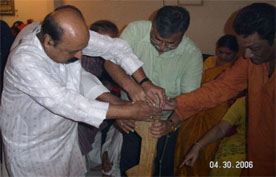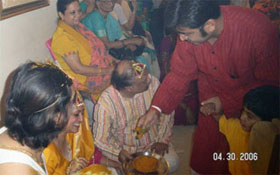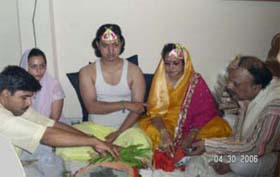Kayastha Wedding
Day-II : rasm # 1
Mandapacchadan : Mandap is established on this day. Mandap is a hey roof made on four bamboo posts and ornamented with banana stumbh and amrapatra (mango leaves) and marigold flowers.It is established in the courtyard of the groom's house.Five senior married men from the family establish the 'harish' ( a symbol of good agriculture) made out of wood, in the center of the mandap. This mandap will hold all the rituals now onwards pertaining to the wedding, starting with Haldi.
rasm # 2
 Haldi: haldi paste brought by the bride's brother plays a significant role in this ritual. Haldi is a disinfectant and the application of this signifies good health.The groom is made to sit down on a low wooden stool with his knees folded and feet together ,in the 'mandap' with only an angvastra , which is unstitched clothes i.e. a dhoti and an 'angoccha' (a stole).
Haldi: haldi paste brought by the bride's brother plays a significant role in this ritual. Haldi is a disinfectant and the application of this signifies good health.The groom is made to sit down on a low wooden stool with his knees folded and feet together ,in the 'mandap' with only an angvastra , which is unstitched clothes i.e. a dhoti and an 'angoccha' (a stole).
A Patmohri is tied by the bua (father's sister)on the forehead of the groom(basically to protect the hair from the application of haldi and highlight the face- as you do for the facial in a parlour) and she holds out her saree pallu over the groom's head while haldi is applied on the groom by the family members one by one.As the members apply, a lot of gaalis (abusive songs)are sung over them , all in good humor and the audience takes a good dig on it. Generally people playfully put haldi on each other also and indulge in harmless flirting.
 The parents of the groom attired in a typical haldi-attire, are also required to sit with the groom for this ritual. The family Punditji recites the mantra for this 'yagya'. The elders in the family shower the parents of the groom's parents with 'nyota', consisting of suhag ke joda for mother and kurta-pyjama for the father. Suhag ka joda consists of saree-blouse, bangles, bindi and sindoor.
The parents of the groom attired in a typical haldi-attire, are also required to sit with the groom for this ritual. The family Punditji recites the mantra for this 'yagya'. The elders in the family shower the parents of the groom's parents with 'nyota', consisting of suhag ke joda for mother and kurta-pyjama for the father. Suhag ka joda consists of saree-blouse, bangles, bindi and sindoor.
Attire : Preferably, Yellow ethnic clothes are worn on this day. The ladies wear sarees and the girls wear salwar - kameez. The gents wear kurta-pyjama.
 The food served on this day generally consists of fish curry,boiled rice,poori, chana daal, peas & paneer curry, kat-hal (jackfruit)goli, along with varieties of other goodies. Tamatar ki meethi chutney, tilori, achar, papad, kheer, dahi-boondi are integral part of each meal.
The food served on this day generally consists of fish curry,boiled rice,poori, chana daal, peas & paneer curry, kat-hal (jackfruit)goli, along with varieties of other goodies. Tamatar ki meethi chutney, tilori, achar, papad, kheer, dahi-boondi are integral part of each meal.
The variety and continuos flow of snacks and sweets all through the wedding days marks the reputation,prestige and stregth of the family and its lineage.
rasm # 3
Dhritdhari , Matripoojan and Paunpooji.
Dhritdhari and the Matripoojan have the same significance. The only difference is that the former is performed to give 'ahwan' (call) to the spirits of the deceased ancestors and seek 'kshama'(forgiveness) as well as the blessings, while Matripoojan is to seek the same from the living elders of the family.The groom and his parents touch the feet of the elders as they come to bless and as a token of thanks-giving ,for their coming to participate in this "yagya", the parents of the groom give them "paun-pooji" in the form of either clothes or cash .
The dinner/lunch served cosists of "khassi'(mutton) preparations. Though in many of the families non-vegetarian recipes are not served. But ,in those where it is served, the number of 'khassis' slaughtered to be served as a variety of preparations, marks the prosperity grading by the folks.This is very prevalent in the 'ambastha kayasthas(a sub-caste in Bihar).